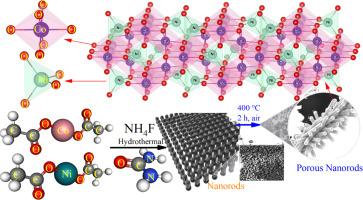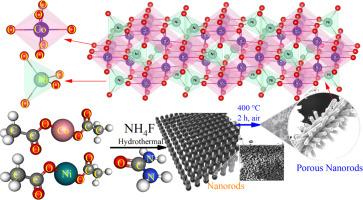碳集成结构调制控制Co2NiO4纳米棒的磁相互作用和畴动力学
IF 9.3
1区 材料科学
Q1 MATERIALS SCIENCE, MULTIDISCIPLINARY
引用次数: 0
摘要
纳米材料具有定制的形貌、微观结构和碳集成,对其光学和磁性能产生深远的影响。在本研究中,采用水热法制备了一系列碳集成的Co2NiO4尖晶石纳米棒,系统地改变了共前驱体的比例,然后在合成后进行低温空气退火。元素分析和Rietveld-refined XRD模式证实了尖晶石晶格中的碳掺杂,改变了晶胞参数和晶体尺寸。电镜研究表明,纳米棒形貌均匀,密度随碳含量的变化而变化,而紫外可见光谱显示,由于碳诱导的中隙状态和结构缺陷,其光带隙可调谐(1.85-2.08 eV)。磁性表征显示,在碳介导缺陷工程和Co/Ni化学计量的驱动下,软铁磁行为在矫顽力、剩余磁化强度和饱和磁化强度方面有系统的变化。一阶反转曲线(FORC)映射进一步揭示了可调节的相互作用场和矫顽力分布,突出了碳诱导钉钉效应和阳离子驱动的超交换相互作用的相互作用。可控的合成和退火过程能够精确调节形态,碳含量和阳离子分布,为设计多功能尖晶石氧化物提供了一条途径,用于先进的应用。本文章由计算机程序翻译,如有差异,请以英文原文为准。


Controlling magnetic interactions and domain dynamics in Co2NiO4 nanorods via carbon integrated structural modulation
Nanomaterials with tailored morphology, microstructure, and carbon integration exhibit profound impacts on their optical and magnetic properties. In this study, a series of carbon-integrated Co2NiO4 spinel nanorods were synthesized via a hydrothermal method by systematically varying co-precursor ratios, followed by post synthesis low-temperature air annealing. Elemental analysis and Rietveld-refined XRD patterns confirmed carbon incorporation within the spinel lattice, altering unit cell parameters and crystallite size. Electron microscopic study revealed uniform nanorod morphologies with density variations correlating to carbon content, while UV–Vis spectroscopy demonstrated tunable optical bandgaps (1.85–2.08 eV), attributed to carbon-induced mid-gap states and structural defects. Magnetic characterization revealed soft ferromagnetic behavior with systematic variations in coercivity, remanent magnetization, and saturation magnetization, driven by carbon-mediated defect engineering and Co/Ni stoichiometry. First-Order Reversal Curve (FORC) mapping further uncovered tunable interaction fields and coercivity distributions, highlighting the interplay of carbon-induced pinning effects and cation-driven superexchange interactions. The controlled synthesis and annealing process enabled precise modulation of morphology, carbon content, and cation distribution, offering a pathway to engineer multifunctional spinel oxides for advanced applications.
求助全文
通过发布文献求助,成功后即可免费获取论文全文。
去求助
来源期刊

Acta Materialia
工程技术-材料科学:综合
CiteScore
16.10
自引率
8.50%
发文量
801
审稿时长
53 days
期刊介绍:
Acta Materialia serves as a platform for publishing full-length, original papers and commissioned overviews that contribute to a profound understanding of the correlation between the processing, structure, and properties of inorganic materials. The journal seeks papers with high impact potential or those that significantly propel the field forward. The scope includes the atomic and molecular arrangements, chemical and electronic structures, and microstructure of materials, focusing on their mechanical or functional behavior across all length scales, including nanostructures.
 求助内容:
求助内容: 应助结果提醒方式:
应助结果提醒方式:


